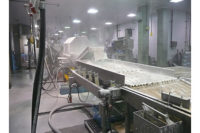How to sustain animal welfare in NAE operations by managing intestinal health

As consumer demand drives more of the poultry industry towards a “No Antibiotics Ever” (NAE) label, more than half of U.S. broilers are raised without ionophore usage. Effective vector and disease management becomes crucial to ensure safety and animal welfare in these operations, with producers searching for new solutions.
While ionophores used to produce conventional broilers provide many advantages including animal health and welfare, sustainability, performance and control of pathogens that cause foodborne illness, the industry must continue to find innovative ways to support NAE production. Approximately 50 percent of all broilers in the US are NAE. NAE production comes with its own unique set of challenges to controlling disease and maintaining animal welfare. Intestinal Integrity and gut health are key parts of animal welfare for antibiotic-free and NAE producers.
“NAE poultry producers have limited options for disease control and need a tailored, well-planned Intestinal Integrity program,” Dr. Francene Van Sambeek, D.V.M., Elanco technical consultant. “An effective program includes careful planning and management strategies, so that when issues arise producers can evaluate and adjust their disease prevention program quickly.”
Poultry gut health is critical to animal welfare in NAE
A robust Intestinal Integrity program that supports gut health and the prevention of coccidiosis is one key component of meeting animal welfare goals. When a bird is infected with coccidiosis, the coccidia in the intestinal tract can lead to diarrhea, which can impact growth and hinder weight gain. If left untreated, coccidiosis can lead to other infections like necrotic enteritis (NE) and cause birds to experience long periods of pain and discomfort and eventually death. Recent data from AgriPulse showed that birds raised in NAE programs had a 6.6% mortality rate compared to conventional broilers at 5.96%.
There are non-antibiotic tools and resources that can be implemented to help support gut health. The three primary non-antibiotic product types available are weak chemicals, strong chemicals and vaccines.
Chemical programs can be used either as standalone programs or rotated with vaccine programs to provide exceptional coccidia control.
Live coccidia vaccines can benefit broiler production because they can help birds build immunity and protect against mortality. Vaccines have proven their efficacy, albeit with some potential downfalls, including:
- Correct vaccine-derived coccidia cycling levels
- Proper mixing and administration of vaccines in the hatchery, ensuring proper dosage
- Added labor and management requirements
- Increased NE incidence in poorly vaccinated flocks, leading to higher mortality
Other in-feed, non-antibiotic products are used to moderate NE effects, which is an additional cost to the producer, but does provide better bird welfare. In some situations, an in-feed anticoccidial product contained in every mouthful of feed provides the birds with a consistent gut health intervention that does not rely solely on their immune system response to a coccidial challenge.
In addition to the use of vaccines and chemicals, there are also important feed and management strategies that help support poultry nutrition and bird health, such as:
- Litter management
- Clean water lines
- Proper ventilation
- Proper bird density
- Prebiotics, yeast products and/or probiotics in the feeding program
- Mild acidifiers like apple cider vinegar added to the water during grow-out
Controlling coccidiosis supports sustainability
Controlling coccidiosis is critical for the continued supply and overall sustainability of the poultry industry. For NAE programs to be successful, producers must give an increased attention to detail to all aspects of the birds’ environment and health programs. Management practices need to focus greater attention on cleanliness, sanitation, and reducing stress levels on broilers in both the hatchery and broiler house environments.
When diseases are not controlled through proper management practices, the bird utilizes more energy from feed and water to fight off disease-causing organisms rather than growing to the desired weight. Even small increases to feed usage can add up quickly. Overall, though, poultry producers have become considerably more efficient with their feed and water resources over the last 50 years. In order to produce 1 pound of chicken 50 years ago, it took 2.4 pounds of feed. Today it only takes about 1.82 pounds of feed: a 24% decrease. This means fewer grains such as soybeans and corn are needed to raise the same number of birds. For example, the poultry industry utilizes 72% less farmland for production and 58% less water than it did in 1965.
Therefore, the improvements in bird health and welfare are directly tied to improved environmental stewardship and disease prevention and control.
Source: Elanco
Looking for a reprint of this article?
From high-res PDFs to custom plaques, order your copy today!








